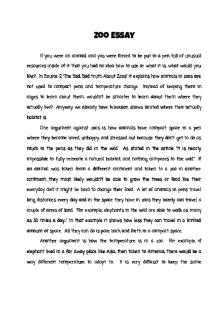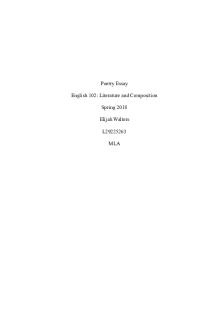Essay \"““Our Common Future”: a critique of the Brundtland report\" - grade B PDF

| Title | Essay \"““Our Common Future”: a critique of the Brundtland report\" - grade B |
|---|---|
| Course | Introduction to Sustainable Development |
| Institution | Murdoch University |
| Pages | 5 |
| File Size | 90.1 KB |
| File Type | |
| Total Downloads | 937 |
| Total Views | 978 |
Summary
Student number: 32719726 Surname: Joensson Given name: Caitlin Email: Unit code: SUS100 Unit name: Introduction to Sustainable Development Date: 4 September 2015 Assignment number: 1 Words: 1363 Tutor: Alka Sabharwal Common a critique of the Brundtland report the Brundtland Report has its obvious qu...
Description
Student number: 32719726 Surname: Joensson Given name: Caitlin Email: [email protected] Unit code: SUS100 Unit name: Introduction to Sustainable Development Date: 4 September 2015 Assignment number: 1 Words: 1363 Tutor: Alka Sabharwal
“Our Common Future”: a critique of the Brundtland report “Although the Brundtland Report has its obvious qualities, it is more a point of departure than an actual manual for sustainable development.” (Wettestad, 1988) In the present day it is difficult to deny the existence of global warming and environmental degradation. But over a quarter of a century ago it was deemed revolutionary for the government to focus on such issues. In 1987, the Brundtland commission released its famous report ‘Our Common Future’ (the Brundtland report) that focused on global sustainable development to improve global well-being, health and life with justice and peace (Renoldner, 2013). The report stressed the need for international economic structures that could begin to close the gap between developing and developed countries. (Hinrichsen, 1987) The report marked a turning point for the discussion of environmental issues, however it has both flaws and strengths and cannot directly be seen as a ‘manual’ for sustainable development but rather a starting point for discussion. In 1983, the World Commission on Environment and Development convened by the United Nations was established in order to address growing concerns regarding the deterioration of environment and resources. The commission was chaired by Gro Harlem Brundtland, the former Secretary General of The United Nations, who aimed to unite countries in a pursuit of implementing a sustainable future. A series of catastrophes occurred during the short lifetime of this commission that helped bring environmental issues to the forefront of environmental discussion. This political spotlight on the environment resulted in the creation of The Brundtland Report. The report focused on governments, businesses and individuals whose welfare was a key driving factor in the development of global environmental policies. The Brundtland report saw environmental issues at the forefront of the political agenda with environment and development being viewed as identical issues. The Brundtland Report may be seen as creating a framework for further political agendas that focused on sustainability. Namely the 1992 Earth Summit, the adaptation of Agenda 21 and the establishment of the United Nations’ Commission on Sustainable Development. (Elkington, 2007) The variation of meaning given to the concept of sustainable development has resulted in many different responses. The Brundtland Report highlighted three fundamental components to sustainable development: environmental protection, economic growth and social equity. The report’s focus on these three issues together is what gives it a reformist standing point on the scale of sustainable development views. Reformists believe that the root of the problem lies in a lack of knowledge rather than in society itself. Unlike those with a transformist approach who believe the problem of unsustainability lies fundamentally within society, reformists see a link between society and the issue, rather than as one being the cause of the other. The reformist ideas in the Brundtland report assert that existing mechanisms for interaction with the environment requires re-evaluation. The Brundtland report however is walking on a fine line between reformist and status quo viewpoints. The report’s approach to
sustainability, while reformist, also evokes the ideals of economic growth and appeases the conservatives in power at that time. The report does this so as to ensure the liability of humankind to sustainably develop while keeping with the already established views on economics and government. (Hopwood, Mellor and O’Brien, 2005) The Brundtland report had many strengths, as well as weaknesses. The main strength of the report was its success in bringing environmental issues to the forefront of International political conversation. The report also showed that issues usually discussed separately are interconnected and promoted the importance of this consideration. The recognition of this is what formed the basis for the emphasis on the need for preventative environmental policymaking at both an international and domestic level. Credit should also be given to the Brundtland report for its plea to integrate economics and ecology within decision and policy making. (Bergesen, 1988) The Brundtland report successfully brought together all states and people to talk collectively about environmental issues. The report did so by emphasizing the common interests of the states in solving global environmental and developmental problems. In some ways, this approach was seen as threatening as the commission used environmental threats as a lever in promoting cooperation. The report suggested that economic growth in the Third World was a global issue and thus in the interest of all: specifically in terms of economics, politics and security. However the views and suggestions surrounding the development of the Third World had its weaknesses. (Bergesen, 1988) The greatest weakness of the Brundtland report lay in its economic requests and goals for developing countries. An important aim of the commission was to provide guidance to the achievement of sustainable development. The suggested national annual income rise was not realistic for any countries but those in the North. The economic goals were unrealistic for developing countries and the report ignored the fact that these countries deal with both environmental and financial problems with greater difficulty compared to developed countries. (Bergesen, 1988) A lack of consideration and knowledge of what is an appropriate economic ask of developing countries, is what resulted in these ‘far-fetched’ ideas. In the present day however, a deeper knowledge of what constitutes reasonable actions that are suited to specific countries may be more easily implemented. Although a weakness in the report, the lack of knowledge surrounding the Third World led to a greater recognition of how each country differs in terms of environmental issues. Critiques have also noted a weakness of the report as being its inability to adequately cover all the issues it aims to. The report is too broad and expansive to outline successfully all the important elements in its writing. Its incorporation of so many different elements may be to appease the multitude of diverse interest groups at the time, however by cutting down its subject pool, the report may have been able to provide better information on certain areas. (Bergesen, 1988)
Although nothing much came of the report at the time of publication, The World Commission on Environment and Development’s document is still very valid today as it shows clearly the
main characteristics and roots of unsustainable development. Since the Brundtland report’s creation, many changes have occurred in the sustainable development field. Looked at globally, sustainable development endeavours are identified by commitments, plans and tools that have been implemented to create a better future. The number of engaged countries and organisations is more impressive than the depth of each commitment. Improvement is still needed, however the occurrence of such events as the Brundtland report have aided in shaping a path forward to improve sustainable development discussions and policy making. (Bass, 2007) The effective implementation of a report today would require further research and consideration due to increases in energy use, pollution and environmental degradation. The world’s political and environmental landscape has changed significantly since the Brundtland report was created. However, we still argue about the concept and practice of sustainable development. (Appleton, 2006) Those seeking to implement change and a sustainable future for all should look back on documents such as the Brundtland report and learn from the strengths and weaknesses behind the ideas they pose.
References Appleton, A. 2006. Sustainability: A practitioner’s reflection, Technology in Society, 28:1 3-18. Bass, Steve. 2007. “Beyond Brundtland.” The World Today. 63 (8): pp. 10-13. Bergesen, Helge Ole. 1988. "Reformism Doomed to Failure? A Critical Look at the Strategy Promoted by the Brundtland Commission." International Challenges 8 (2): pp. 6-10. Dresner, S. 2008. ‘From Rio to Kyoto and later disappointments’. In Dresner, S. The Principles of Sustainability. pp. 41-53. London: Sterling Elkington, John. 2007. “Brundtland and Sustainability: history’s balance-sheet” Hinrichsen, Don. 1987. Our Common Future. London: Earthscan. Hopwood, B, Mellor, M and O’Brien, G. 2005. Sustainable Development: Mapping Different Approaches. Sustainable Development. 13(1): pp. 38-52. Renoldner, Klaus. 2013. 'Rethinking ‘Our Common Future’: A Physician’s Remarks 25 Years After The Release Of ‘Brundtland Report’'. Medicine, Conflict And Survival 29 (4): pp. 278-288. Wettestad, Jørgen. 1988. The Brundtland Report: Strengths and Weaknesses. International Challenges 8 (1): pp. 27....
Similar Free PDFs

Our Guys Critique - Grade: A
- 3 Pages

Media Critique - Grade: B
- 7 Pages

The Watchmen Essay - Grade: B
- 3 Pages

Critique 1 - Grade: A+
- 4 Pages

Rogerian Essay - Grade: B
- 2 Pages

Zoo Essay - Grade: B+
- 2 Pages

Causation Essay - Grade: B
- 4 Pages

Final Essay - Grade: B+
- 12 Pages

Propaganda Essay - Grade: b
- 4 Pages

Poetry Essay - Grade: B
- 5 Pages

Galileo Essay - Grade: B+
- 6 Pages

Fiction Essay - Grade: B
- 7 Pages

EPQ Essay - Grade: B+
- 10 Pages
Popular Institutions
- Tinajero National High School - Annex
- Politeknik Caltex Riau
- Yokohama City University
- SGT University
- University of Al-Qadisiyah
- Divine Word College of Vigan
- Techniek College Rotterdam
- Universidade de Santiago
- Universiti Teknologi MARA Cawangan Johor Kampus Pasir Gudang
- Poltekkes Kemenkes Yogyakarta
- Baguio City National High School
- Colegio san marcos
- preparatoria uno
- Centro de Bachillerato Tecnológico Industrial y de Servicios No. 107
- Dalian Maritime University
- Quang Trung Secondary School
- Colegio Tecnológico en Informática
- Corporación Regional de Educación Superior
- Grupo CEDVA
- Dar Al Uloom University
- Centro de Estudios Preuniversitarios de la Universidad Nacional de Ingeniería
- 上智大学
- Aakash International School, Nuna Majara
- San Felipe Neri Catholic School
- Kang Chiao International School - New Taipei City
- Misamis Occidental National High School
- Institución Educativa Escuela Normal Juan Ladrilleros
- Kolehiyo ng Pantukan
- Batanes State College
- Instituto Continental
- Sekolah Menengah Kejuruan Kesehatan Kaltara (Tarakan)
- Colegio de La Inmaculada Concepcion - Cebu


